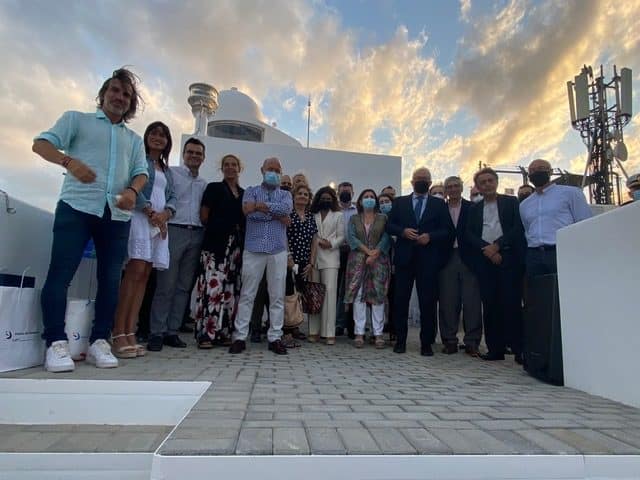From a distance of 24 nautical miles you can now see the intermittent flashes from the brand-new Mojácar Lighthouse, which officially entered into service on the evening-night of 22nd September 2021, the time when simultaneously the Garrucha Lighthouse lantern was turned off after 140 years of service.
This date, as highlighted by the Mayor of Mojácar, Rosa María Cano, and the president of the Almería Port Authority (APA), Jesús Caicedo, will go down in the history of the province’s navigation aid signals, and of that of Mojácar municipality in particular.
This the Mojácar Mayor and the APA president affirmed, as did the province’s social and economic agents, who participated in the turning on of the new lighthouse’s lantern.
Rosa María Cano highlighted the importance for the municipality of this new location, which “puts Mojácar on the navigation maps of the whole world.”
The Mayor trusts it will be yet another attraction for attracting new tourists and visitors to the municipality at the same time as having been able to recover a space of singular beauty, the Cerro del Moro Manco, with extraordinary views over the Mojácar coastline and the Mediterranean.
Jesús Caicedo thanked Mojácar Council and State Ports for the support they have given right from the start for enabling the project to go ahead, and also thanked the companies Grupo Parra, Marquit and MSM Mediterráneo for the work they have carried so as to today make the lighthouse a reality. He also publicly recognised the work and efforts of the Port Authority Navigation Aids System team and of all the APA personnel.
The Mojácar Lighthouse stands on the highest point of the municipality, at level 150 on the northern side of the Cerro del Moro Manco hill in the Marina de la Torre residential area, on a 250sqm plot ceded by the Local Council.
As well as the structure housing the beacons, the lighthouse project includes the operations hut, the remodelling of the access road and a viewing point and garden area, from where you can see a good part of the Levante region of Almería coast. The action, with an investment of 280,000 euros (VAT included), has been carried out by the APA, charged to the Inter-port Compensation Fund approved by State Ports.
Due to the need for ‘daytime marking’ – that is, that the lighthouse building has to be visible from the sea during the day – a compact volume has been designed to house the lighthouse lantern and the auxiliary units. The lighthouse lantern stands out at the highest point of the complex, the base of which houses the building’s auxiliary areas: office, toilet and battery room.
When it comes to its design, maximum integration into the surroundings has been sought. The lighthouse is a singular building, white, with a Mediterranean appearance, which follows the line of ‘Mojaquera’ architecture in the urban parts of the town. The lighthouse building, as well as the rest of the works, have been carried out by Grupo Transformaciones y Embalses Parra, the manager of which explained the main characteristics of the works.
The company MSM Mediterráneo Señales Marítimas has supplied the lighthouse equipment. It consists of a glazed lantern at a 180º angle with a hemispherical dome. Inside the lantern there is a modern long-range rotating MBR 900 beacon, which functions as the main beacon, with a two-position lamp changer, a back-up rotation system and its corresponding control panel.
Likewise, a two-level, sectorised MBL500LD ‘flashing’ beacon model has been installed, which acts as an emergency beacon. This beacon also has its own control panel and a solar panel with a photovoltaic power system, generator set and several battery modules, which guarantees the functioning of the signal in the event there is a failure in the main equipment.
The Mojácar lighthouse range of action goes from Macenas beach to Águilas in Murcia Region, with an effective light intensity of more than 24 nautical miles.
The lighthouse inauguration was attended by a notable representation of the public administrations. Among other authorities, there was the Government Sub-Delegate, Manuel de la Fuente; the Junta de Andalucía Government delegate, María Isabel Sánchez, Health and Families delegate, Juan de la Cruz Belmonte, Development, and Infrastructure, Urban Planning, Culture and Historic Heritage Almería delegate, Eloísa Cabrera. The Levante region of Almería mayors, the Almería Chamber of Commerce President, Jerónimo Parra, and several representatives of regional businesses and entities, among other authorities, also took part in the event.





